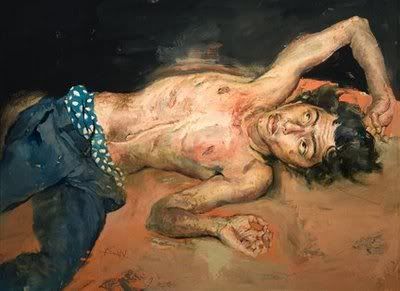
Just now, as I sat down to type this, I turned off the TV.
Why?
Well, I needed to concentrate. To
THINK. And it's very hard to do that when the TV is on. Actually, let me back up just a bit....
There's really a
hierarchy to it. I find if there's music playing, assuming it's instrumental or nothing too intense (like punk rock or death metal or something) I can concentrate just fine (I have iTunes playing now). But I've noticed (and this becomes eminently clear when you're trying to WRITE) - that when someone starts talking, the concentration goes down a notch or two. I probably would never have noticed, until the
COMMERCIALS came on!!! Geeze Louise!!!!
ANNOUNCERS WITH CRAZY LOUD VOICES SHOUTING INCESSANTLY TO BUY BUY BUY!!!!! Stops the pen dead in its tracks.
Which led me to realize that we automatically
tune in to the human voice... especially when it's in a language we know, and ESPECIALLY if there's any great urgency or tension in it! Don't believe me? Try it.... open a notebook, or maybe your text edit software, and start writing something. I don't mean "Mary had a little lamb" or anything you know by rote... I mean something that requires
THINKING. Try telling the story of the scariest thing that ever happened to you. And do it with the radio on pretty loud. You'll do pretty good I'll bet, until those
CRAZY LOUD ANNOUNCERS INVADE YOUR HEAD!!!! I believe it's similar to what I've heard about vision and the human face.... we're all
hardwired to scan for familiar faces, even in a huge crowd. Some function that runs in the backchannel, we're not consciously aware of it. Probably a survival mechanism from way back.
So, what does this mean to us as filmmakers? I think it means that
talking in a movie doesn't allow the viewer to THINK. It leads them.... corrals them. I don't believe it completely BRAINWASHES them.... though for some viewers it might. Most are able to pick up on SUBTEXT (that's when people don't say exactly what they mean) - but I suspect that's about it. They either
believe what they're being told, or they pick up on the clues and realize they're being lied to (another old survival skill, I have no doubt). And I'll even go one better.... I think as viewers we can solve simple puzzles presented in dialogue or narration too.... put together clues in a detective flick, or whatever. But still, we're being led into what we're supposed to think. These are all levels of varying complexity put there by the writer for us to decode. But I still maintain that,
WHILE CHARACTERS OR NARRATORS ARE TALKING, we have no choice but to think about what they're saying. Decide whether we believe it or don't.
Another illustration of the power of the human voice - I remember sleeping once with the radio on - this was in the 70's. Remember those
Oxy-10 commercials? They had this voiceover by an actor with a
really commanding, authoritarian voice. I was in mid dream when he came on, and suddenly my subconscious was forced to invent a character to match this loud voice that came from nowhere. It did one of the sudden, unmotivated switcheroos - I had been climbing among the rigging over a theater where a performance was going on (with some group of dangerous spies and assassins infiltrated into the audience and the performers, and only I was aware of their presence). Suddenly with a shock I found myself standing in an office, being spoken to very loudly by this
administrator-type with (you guessed it) a deep, commanding voice. For some reason he spoke in code... he seemed to be babbling inanities about skin pores and cleansing, but I knew it all had hidden meaning (something along the lines of spy cells and murder), and the very continued existence of life on earth depended on my decoding it. The dream kept going in the way dreams do, sudden jump cuts to scenes already in progress etc, but throughout my head was filled by this
booming oration -
see, even as I made my escape the secret leader of the spy/assassin group was using his telepathic powers to project his commanding powers of persuasion into my mind.
So, obviously the human voice has a
great deal of power over us. This fact might explain why silent movies are harder to watch than 'talkies'. The constant stream of
verbiage rivets the viewer's attention, even if there's nothing of any great interest happening in the film. But without it, viewers have to force themselves to continue paying attention.
Draw your own conclusions.
The voice is a powerful tool.... much more so than we normally realize (barkers and infomercial hawkers excepted). Use it like an instrument. Orchestrate it.
One of the benchmarks of the more
poetic films I like is long periods of
silence punctuated by voice, often used as an instrument. And please.... don't be droll enough to
say what you mean and mean what you say! So trite.







